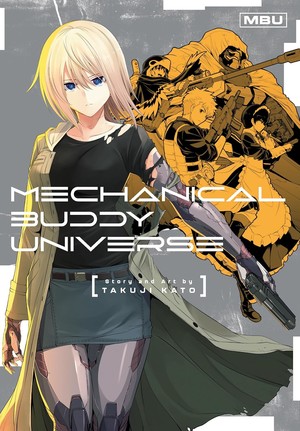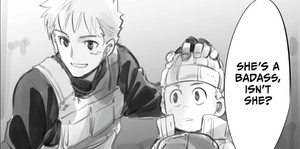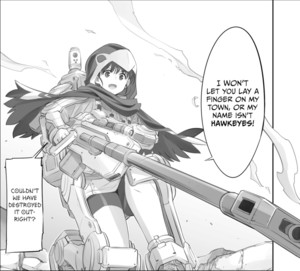The Fall 2025 Manga Guide
Mechanical Buddy Universe
What's It About?

An android that has completed its original mission. A baby that was abandoned in a war-torn city. In this futuristic dystopia, the two meet on a rainy day. Thus, the machine and the human become mother and child…
Mechanical Buddy Universe has art and story by Takuji Katō. English translation is done by David Evelyn and lettering by Richmond Torrefranca. Published by Square Enix (September 23, 2025). Rated T.
Is It Worth Reading?
Rebecca Silverman
Rating:

There's really no one good way to describe Mechanical Buddy Universe. If I had to pick one, I'd say that it's about the ways humans interact with androids in a distant post-apocalyptic future, but that's really only the surface of the book. Comprised of several separate stories of human/machine pairs, the manga plays with different relationships exploring the humanity of machines who live alongside people, and how human nature basically influences (or perhaps “infects”) the world around it. The most interesting way this is played with is in the final chapter, which uses sci fi technology to essentially recreate Japanese urban legends – a (mostly) dead girl becomes a mechanical slit-mouth woman, a skinned man turns into a nopperabo (no-face), and a definitely dead girl becomes a teke-teke, her exposed spine fluttering like a tail. It's creepy in the best way, and I'd love to see Takuji Katō return to expand it, since it's the shortest piece in the book.
The longest is the opening chapter, about an android who finds an abandoned baby and decides to raise him. Interestingly enough, this decision also leads to the android to identifying as a woman: she has a baby, so she's his mother seems to be the logic she's following. (Her misguided attempts to appeal to him with large breasts are uncomfortably funny, since she's clearly not entirely sure what the difference between familial and romantic love is.) For his part, her son knows his mom's not human, but he doesn't care; she's his mom, full stop. Their slice-of-life, found-family narrative unfolds against a violent backdrop where they work as mercenaries, but it's all presented so calmly that it almost doesn't matter.
That's an overarching element of the book as a whole: the world maybe ended, but life goes on. In the chapter focused on an old soldier known as The Banshee, we do see the toll war has taken; the slit-mouth woman has a direct tie to the battles she fought. Similarly, the Hawkeye automated AI machine gun in chapter two details their evolution since the war ended, and how watching people allowed them to develop a sense of self and emotions. They've grown, Banshee has stagnated in the PTSD aftermath, and everyone just…carries on. There's something remarkably human about it all.
This is probably a book best read in chapter chunks rather than all at once. The stories do converge at points, but it works best if you take time to absorb it a chapter at a time, because there are so many little details in both the (attractively messy) art and writing. It's hard to describe, but worth taking the time to experience.
Kevin Cormack
Rating:

Ever since Czech writer Karel Čapek's 1920 play Rossum's Universal Robots, the relationship between mankind and their artificial servants has been a fertile ground for literature, with notable film examples ranging from the more terrifying (James Cameron's Terminator) to the saccharine (Spielberg/Kubrick's A.I.). Takuji Katō's Mechanical Buddy Universe skews more towards the optimistic Spielbergian end, with humans and humanoid droids coexisting together in a seemingly post-apocalyptic city. Constructed as an anthology of linked stories, it features an odd mix of longer narrative chapters and shorter, non-chronological skits that fill in backstory.
We first meet an unnamed droid who happens upon an abandoned baby, and failing to find any human to adopt him, assumes the role of his mother, even going as far as to purchase a convincing female skin covering (with adjustable size breasts, obviously). Much of the volume follows these two characters as they grow older together, and the droid begins to feel emotions she was never programmed to experience. It's extremely sweet, humorous, and even a little melancholy at times.
Later, we're introduced to other duos, such as a young girl partnered with a sentient sniper rifle that just happens to have fallen in love with her. Then there's the android double for a dead noblewoman, forever accompanied by her devoted human maid, and the grizzled veteran female soldier Banshee, called so for her wails of despair on the battlefield in her younger days.
They're an eclectic cast, many of whom only begin to interact with one another late in the volume, which leaves any underlying plot (of which there isn't much) feeling distinctly underdeveloped by the end of the generous 320-page volume. Thankfully, at least two sequel volumes are due for English-language publication next year.
Takuji Katō's art style varies wildly across different chapters – sometimes very detailed, reminiscent of other serious SF manga, and at other times much looser and more sketch-like, depending on the tone. It gives the impression that some chapters are merely extras interspersed between the real story, and for all I know, that may be deliberate.
I found the majority of Mechanical Buddy Universe to be entertaining and emotionally rewarding. A couple of the middle chapters do drag a little, as the characters they focus on don't interest me as much as the mother/son or noblewoman/maid pairs, but I'm still keen to read further volumes to discover how the gradually growing cast will interact in this intriguing, ramshackle world.
discuss this in the forum (2 posts) |
back to The Fall 2025 Manga Guide
Seasonal homepage / archives